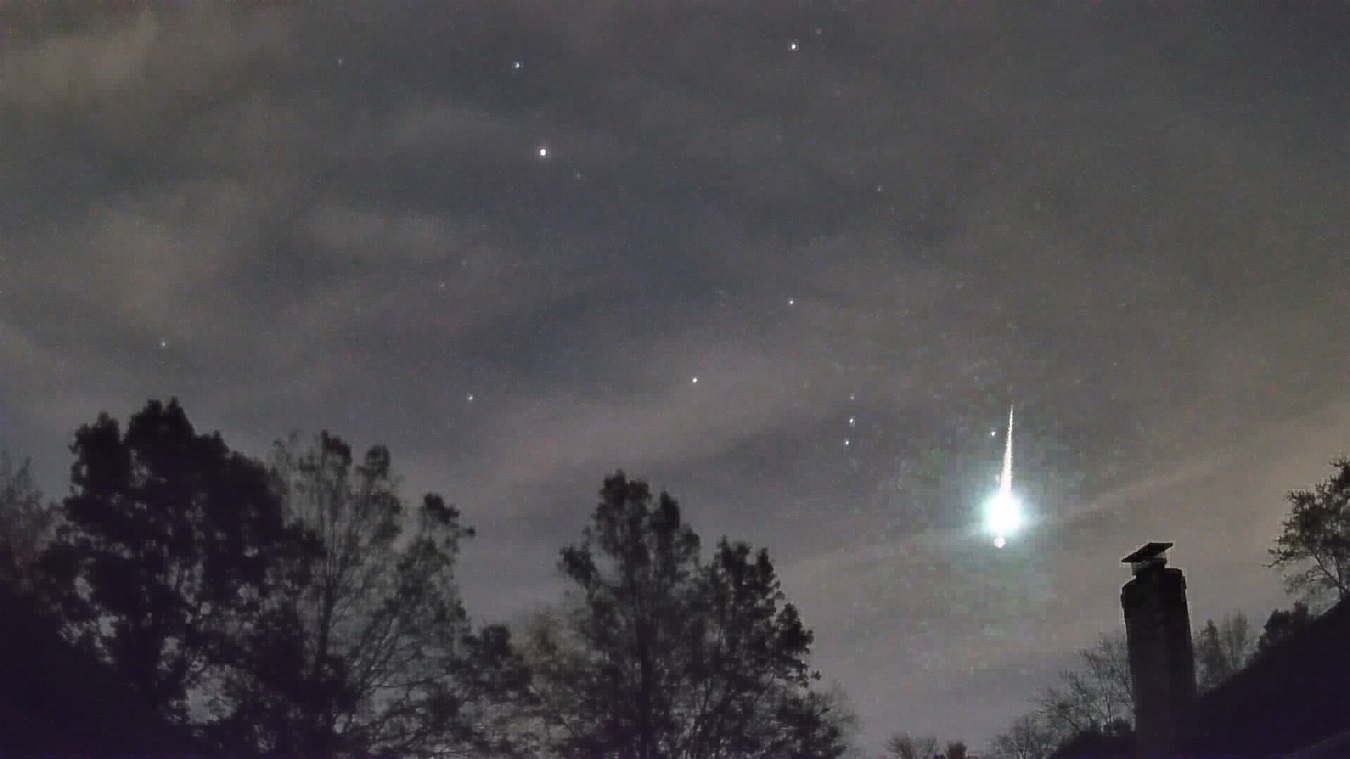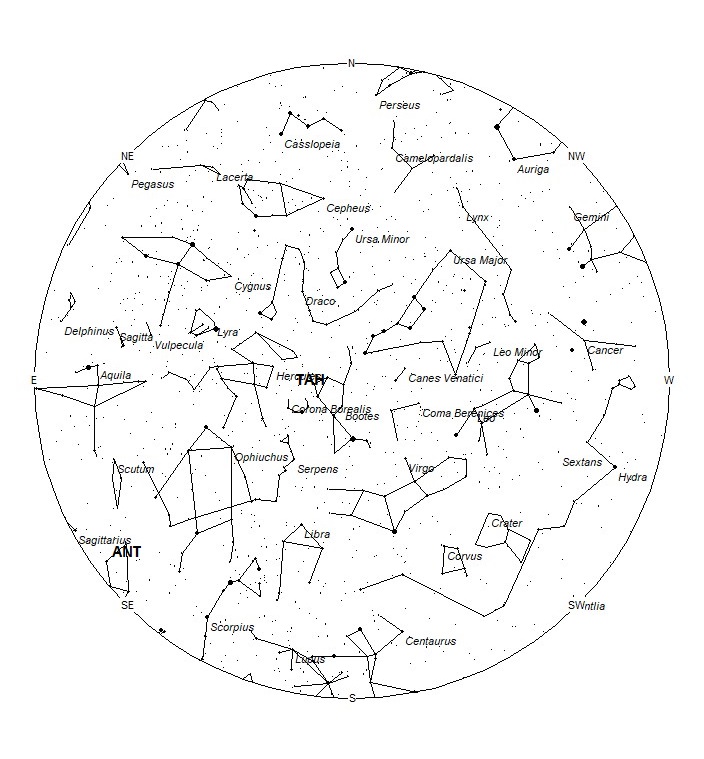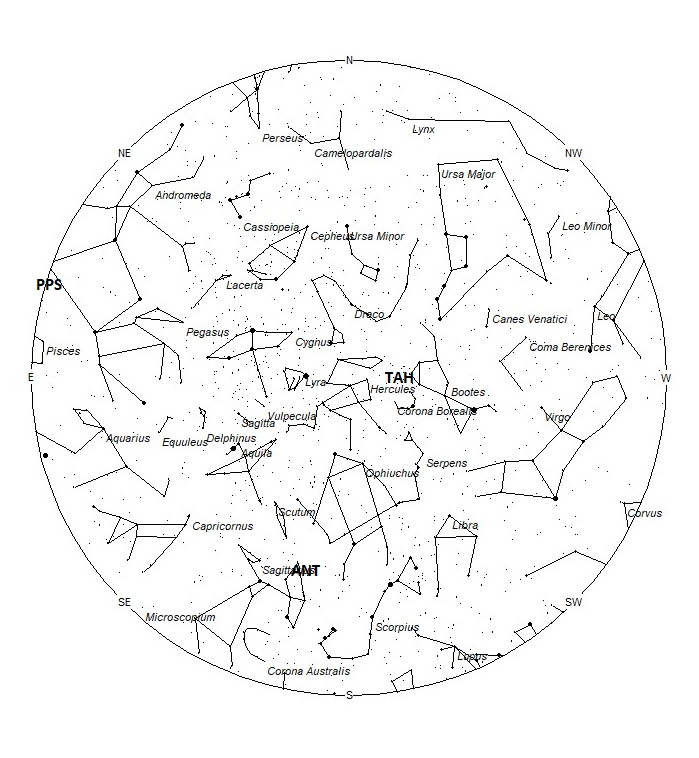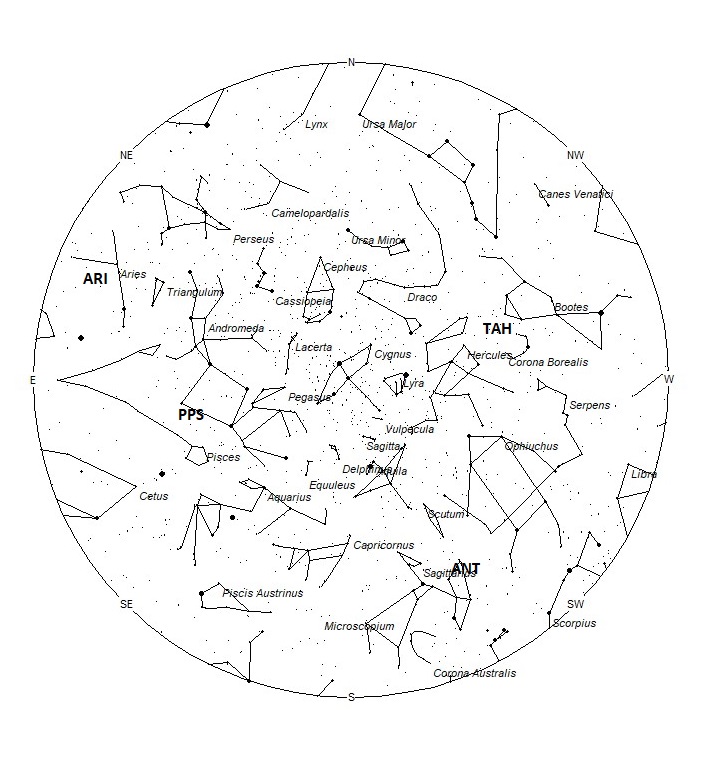 Ryan Conner captured this brilliant Southern Taurid fireball using his AllSky Camera System on October 28, 2022, at 01:14 EDT (5:14 UT) from North Royalton, Ohio, USA. Notice that the fireball passes close to Rigel (beta Orionis), the brightest star in the constellation of Orion. ©Ryan Conner
Ryan Conner captured this brilliant Southern Taurid fireball using his AllSky Camera System on October 28, 2022, at 01:14 EDT (5:14 UT) from North Royalton, Ohio, USA. Notice that the fireball passes close to Rigel (beta Orionis), the brightest star in the constellation of Orion. ©Ryan ConnerDuring this period, the moon reaches its last quarter phase on Saturday June 10th. At that time it will rise between 01:00 and 02:00 local daylight saving time (LDST) and will remain above the horizon the remainder of the night. It will be a slight nuisance to meteor observing but one can simply view toward another direction to avoid the moon’s glare. Toward the end of the week the thin crescent moon will rise just prior to dawn and will not interfere with meteor observing. The estimated total hourly rates for evening observers this week should be near 2 as seen from mid-northern latitudes (45N) and 4 as seen from tropical southern locations (25S) For morning observers, the estimated total hourly rates should be near 6 as seen from mid-northern latitudes (45N) and 10 as seen from tropical southern locations (25S). The actual rates seen will also depend on factors such as personal light and motion perception, local weather conditions, alertness, and experience in watching meteor activity. Morning rates are slightly reduced during this period due to moonlight. Note that the hourly rates listed below are estimates as viewed from dark sky sites away from urban light sources. Observers viewing from urban areas will see less activity as only the brighter meteors will be visible from such locations.
The radiant (the area of the sky where meteors appear to shoot from) positions and rates listed below are exact for Saturday night/Sunday morning June 10/11. These positions do not change greatly day to day so the listed coordinates may be used during this entire period. Most star atlases (available at science stores and planetariums) will provide maps with grid lines of the celestial coordinates so that you may find out exactly where these positions are located in the sky. I have also included charts of the sky that display the radiant positions for evening, midnight, and morning. The center of each chart is the sky directly overhead at the appropriate hour. These charts are oriented for facing south but can be used for any direction by rotating the charts to the desired direction. A planisphere or computer planetarium program is also useful in showing the sky at any time of night on any date of the year. Activity from each radiant is best seen when it is positioned highest in the sky, either due north or south along the meridian, depending on your latitude. It must be remembered that meteor activity is rarely seen at its radiant position. Rather they shoot outwards from the radiant, so it is best to center your field of view so that the radiant lies at the edge and not the center. Viewing there will allow you to easily trace the path of each meteor back to the radiant (if it is a shower member) or in another direction if it is sporadic. Meteor activity is not seen from radiants that are located far below the horizon. The positions below are listed in a west to east manner in order of right ascension (celestial longitude). The positions listed first are located further west therefore are accessible earlier in the night while those listed further down the list rise later in the night.
These sources of meteoric activity are expected to be active this week.
.
The last of the tau Herculids (TAH) are expected this week from a radiant located near 15:38 (235) +38. This area of the sky is located in northwestern Corona Borealis, 2 degrees southeast of the faint star known as mu Coronae Borealis. This is not close to the star tau Herculis, for which this shower is named. Apparently, the discoverers of this display placed the radiant further east toward Corona Borealis and Hercules. It’s also possible that past displays from this source had a different radiant area. This area of the sky is best placed near 2300 (LDST), when it lies high overhead for observers located in mid-northern latitudes. These meteors are visible from the Southern Hemisphere, but the radiant is located low in the northern sky. Therefore, rates would only be a fraction of what is visible from sites further north. Unlike last year, no exceptional activity is expected from this source in 2023. Rates are not expected to be more than 1 meteor per hour, if that much. With an entry velocity of 15 km/sec., the average tau Herculid meteor would be of very slow velocity.
The center of the large Anthelion (ANT) radiant is currently located at 18:12 (273) -23. This position lies in northwestern Sagittarius, 3 degrees northwest of the 3rd magnitude star known as Kaus Borealis (lambda Sagittarii). Due to the large size of this radiant, Anthelion activity may also appear from southeastern Ophiuchus as well as western Sagittarius. This radiant is best placed near 0200 LDST, when it lies on the meridian and is located highest in the southern sky. Rates at this time should be near 1 per hour as seen from the Northern Hemisphere and 2 per hour as seen from south of the equator. With an entry velocity of 30 km/sec., the average Anthelion meteor would be of slow velocity.
The phi Piscids (PPS) have been found to be comprised of two components with separate activity periods. Component A is active from June 13 through July 5 with maximum activity occurring on June 25th. Current rates are less than 1 meteor per hour. The position of the radiant lies near 23:59 (000) +14. This position lies in southeastern Pegasus, 3 degrees southwest of the 3rd magnitude star known as Algenib (gamma Pegasi). This area of the sky lies highest in the eastern sky during the last hour prior to dawn. With an entry velocity of 66km/sec., these meteors are swift. It’s interesting to note that this shower starts near the same position of where the eta Aquariids end. But a comparison of the orbital elements shows no similarities so the two showers are unrelated.
The last of the Daytime Arietids (ARI) are expected this week from a radiant located near 03:04 (046) +25. This area of the sky is located in eastern Aries, 4 degrees southeast of the 4th magnitude star known as Bharani (41 Arietis Aa). Current rates are expected to be less than 1 no matter your location. With an entry velocity of 41 km/sec., the average meteor from this source would be of medium velocity. For radio observers, this is the best time of the year to detect meteors by radio or radar as this shower and the Daytime zeta Perseids are near maximum activity. Peak radio times would be near 11:00 LDST.
As seen from the mid-northern hemisphere (45N) one would expect to see approximately 5 sporadic meteors per hour during the last hour before dawn as seen from rural observing sites. Evening rates would be near 2 per hour. As seen from the tropical southern latitudes (25S), morning rates would be near 8 per hour as seen from rural observing sites and 3 per hour during the evening hours. Locations between these two extremes would see activity between the listed figures. Morning rates are slightly reduced due to moonlight.
You can keep track of the activity of these meteor showers as well as those beyond the limits of visual observing by visiting the NASA Meteor Shower Portal. You can move the sky globe to see different areas of the sky. Colored dots indicate shower meteors while white dots indicate sporadic (random) activity. The large orange disk indicates the position of the sun so little activity will be seen in that area of the sky.
The list below offers the information in tabular form of the showers that I feel are within reach of the visual observer to discern. Hourly rates are often less than 1 but noting parameters such as the radiant distance and the elevation of each meteor, one can compute the probability of shower association. Most showers discovered by video means have rates less than 1 meteor per night away from maximum, so the showers listed in these articles are not as weak as they seem. Rates and positions are exact for Saturday night/Sunday morning except where noted in the shower descriptions.
| SHOWER | DATE OF MAXIMUM ACTIVITY |
CELESTIAL POSITION | ENTRY VELOCITY | CULMINATION | HOURLY RATE | CLASS |
| RA (RA in Deg.) DEC | Km/Sec | Local Daylight-Saving Time | North-South | |||
| tau Herculids (TAH) | Jun 03 | 15:38 (235) +38 | 15 | 23:00 | <1 – <1 | III |
| Anthelion (ANT) | – | 18:12 (273) -23 | 30 | 02:00 | 1 – 2 | II |
| phi Piscids (PPS) | Jun 25 | 23:59 (000) +14 | 66 | 08:00 | <1 – <1 | IV |
| Daytime Arietids (ARI) | Jun 05 | 03:04 (046) +25 | 41 | 11:00 | <1 – <1 | I |
Class Explanation: A scale to group meteor showers by their intensity:
- Class I: the strongest annual showers with Zenith Hourly Rates normally ten or better.
- Class II: reliable minor showers with ZHR’s normally two to ten.
- Class III: showers that do not provide annual activity. These showers are rarely active yet have the potential to produce a major display on occasion.
- Class IV: weak minor showers with ZHR’s rarely exceeding two. The study of these showers is best left to experienced observers who use plotting and angular velocity estimates to determine shower association. These weak showers are also good targets for video and photographic work. Observers with less experience are urged to limit their shower associations to showers with a rating of I to III.
 American Meteor Society
American Meteor Society



Nice post. I was checking constantly this weblog and
I am inspired! Very helpful info particularly the last section :
) I care for such information a lot. I used to be seeking this particular info for a very long time.
Thank you and good luck.